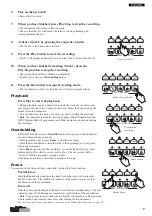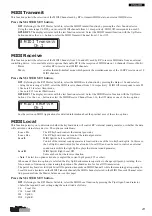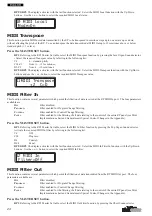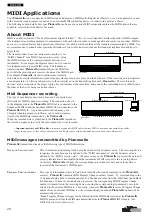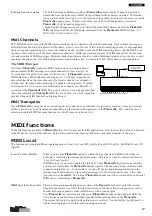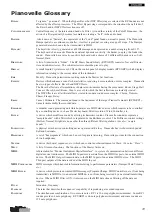
31
Pianovelle Glossary
B
YPASS
:
To ignore, “go around”. When the Bypass Reverb or DSP Effect stage is selected, the RP Sounds are not
affected by the effects processors. The Effect Bypass stage corresponds to the situation when all leds of
the Reverb and/or DSP Effects sections are off.
C
UTOFF
FREQUENCY
:
Central frequency of the intervention band of a Filter. Around the vicinity of the Cutoff Frequency, the
action of a filter gradually becomes less marked, creating a “bell” in the audio band.
D
AMPER
:
Also known as “Sustain”; the equivalent of the “Loud” pedal found on acoustic pianos. The Pianovelle
Damper pedal is a continuous controller - its effect is gradual, covering a range of 8 steps. The Damper
generates data which can also be transmitted via MIDI.
D
YNAMIC
:
The keystrike velocity, generated as a MIDI message and expressed as a number ranging from 0-127.
The keyboard of an acoustic Piano has a natural dynamic sensitivity: the harder you play, the louder the
sound. Pianovelle has a velocity-sensitive keyboard with a choice of 3 different Dynamic curves: Soft,
Normal, Hard.
D
IRECTORY
:
A list of items inside a “folder”. The RP Music Sound Library (RP2/GRP3) consists of several Directo-
ries and sub-directories. The sub-directories contain the pieces to play.
D
ISPLAY
:
A small Liquid Crystal screen (LCD) on the control panel of display models (RP2/GRP3) which displays
information relating to the current status of the instrument.
E
DIT
:
Modify. Pianovelle permits minor editing tasks in the Master Set functions.
E
FFECTS
:
Devices which enhance a sound’s characteristics, rendering it more realistic or more complex. Pianovelle
has two types of effects: Reverb and DSP Effects.
The Reverb effects are all simulations of natural environments having the same name: Room, Stage, Hall,
Concert, Church, Small Room. Slap is a reverb in which the first reflections are instantly created.
The DSP Effects are all artificial effects created to render a sound more complex: Chorus, Tremolo,
Phaser, Flanger, Delay.
E
RASE
:
Cancel, Eliminate. The command found in the Sequencer of the larger Pianovelle models (RP2/GRP3).
Cancels irremediably the recorded data.
E
XPANDER
:
A modular sound generating unit which operates as a MIDI slave device which requires to be controlled
by a controlling device such as a Master keyboard, Midi Accordion, Wind Controller, etc..
F
ILTER
:
A device which modifies a sound by altering its harmonic content. Pianovelle sounds incorporate a
“sample header” with a filter which is regulated by the Brilliance control. The Brilliance control settings
(Mellow, Normal, Bright) are none other than three different filter regulations. (See also “sample
header”)
F
OOTSWITCH
:
A physical switch action controlling device operated with a foot. Pianovelle has two footswitch pedals:
Soft and Sostenuto.
H
EAPHONES
:
A set of “head-speakers” which can be used for private listening. Pianovelle provides for the connection
of two headphones.
M
ASTER
:
A device (keyboard, sequencer, etc.) which can control another instrument or Slave. (See also “Slave”).
M
ENU
:
A list of items or functions. The functions of the Master Set menu.
MIDI:
Abbreviation for “Musical Instrument Digital Interface”. A system of communication between different
digital musical instruments. The MIDI In port receives data from the MIDI Out port of an external MIDI
device. The MIDI Out port transmits data to the MIDI In port of an external MIDI device. The MIDI
Thru port outputs all the data received at the MIDI In port.
MIDI C
ONTROLLERS
:
MIDI messages which transmit information relating to performance parameters (Damper, Main Volume,
etc.).
MIDI F
ILTER
:
A device which prevents unwanted MIDI messages (Program Change, MIDI Controllers, etc.) from being
transmitted via MIDI Out to an external MIDI device or from being received by an external transmitting
device. When a MIDI Filter is ON, it intervenes on the MIDI data stream, filtering off the data not
required.
P
ITCH
:
Intonation, Frequency.
P
LAYBACK
:
The term that describes the sequencer’s capability of reproducing a recorded sequence.
P
OLYPHONY
The simultaneous combination of two or more notes. RP1 is 32-note polyphonic (minimum). Some RP1
sounds provide 64 note polyphony. RP2/GRP3 is 64-note polyphonic (minimum) and some sounds are
128 note polyphonic.
Содержание Pianovelle GRP3
Страница 34: ...34...

